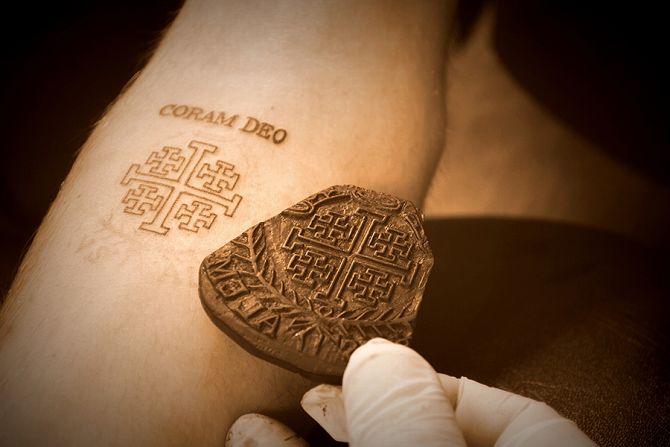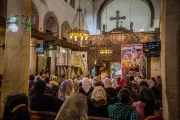Artifacts and application
The walls of the shop bear witness to this family legacy. Alongside framed newspaper clippings highlighting the work of Wassim and his father, Anton, are shadow boxes with pictures of the Razzouk tattoo artists that preceded them: Wassim's grandfather, Yacoub, and great-grandfather, Jirius. And artifacts like an early tattoo machine and a traditional hand tool for manually applying tattoo ink are preserved behind glass.
Historically, Christian tattoo artists created their own inks and used stamps to apply images to the skin, before tracing over them with the tattoo implements. While Wassim does not use the old family ink recipe of soot and wine – using instead sterile inks produced specifically for tattoo application – many of the family's 168 historic wooden stamps are still in use today.
In ages past, the tattooist would use the carved wooden stamp directly upon the pilgrim's skin, and then use it as a guide for the traditional tattoo instruments. Today, Wassim stamps the design onto transfer paper, which is then applied to the skin for tracing, similar to the process for more contemporary design transfers.
More in Middle East - Africa

Over the course of my interview with Wassim, nearly every customer used one of these ancient artifacts as part of their tattoo design. Two women from western Armenia – lands now controlled by eastern Turkey – came in and explained that they had just completed their pilgrimage to the Holy Land and wanted to get a traditional pilgrim's tattoo with no alterations.
They both picked a stamp of the traditional Armenian Cross, a small crucifix that incorporates delicate floral design elements. Razzouk's work was finished by adding the year "2017" underneath the image of the cross to commemorate the year of their pilgrimage. If they ever return, Wassim explained, the year of each additional pilgrimage will be added underneath.
After the women left, I was shown a drawer filled with dozens of the carved wooden stamps, each holding a unique design. Several stamps were based upon the Jerusalem cross: a cross with arms of equal lengths, with smaller crosses in each of its quarters. Others offered representations of the Virgin Mary, St. Michael the Archangel, the Resurrection, lambs, roses, or the star of Bethlehem. Each of them held deep Christian symbolism and a story behind its meaning.
Most of these wooden blocks, carved from olive and cedar wood, are believed to date back to the 17th century, before the Razzouk family relocated permanently to Jerusalem. However, since only two of the stamps have confirmed dates of carving – from 1749 and 1912 – it's difficult to say for sure. However, Wassim's mother, Hilda, told me that it's believed many of the blocks may date back at least 500, maybe 600 years, to the Razzouk family's early days of tattooing in the Holy Land.
Saving a centuries-old tradition
Despite the deep roots of this ancient art form and rite of passage for Christians coming to the Holy Land, traditions of Christian tattooing in Jerusalem have come close to extinction on several occasions.
(Story continues below)
Subscribe to our daily newsletter
In the 1947 War for Israeli Independence, many of the Palestinians who practiced tattooing fled from Jerusalem for their safety, including the Razzouk family. After the war, the Razzouk family returned, but they were nearly alone in doing so: few other Christian tattoo artists decided to return, leaving Razzouk Ink as the last ancient Christian tattoo parlor.
The Razzouk family tradition came under threat again a little more than ten years ago, when Wassim and his siblings decided to pursue other professions.
"I didn't really want to do this," Wassim told me. "I wasn't into tattooing and since this was sort of a responsibility, I didn't want to do it."

Instead, Wassim studied hospitality and pursued other interests.
"One day I was reading something online, an old article where my father was being interviewed," Wassim recalled.




